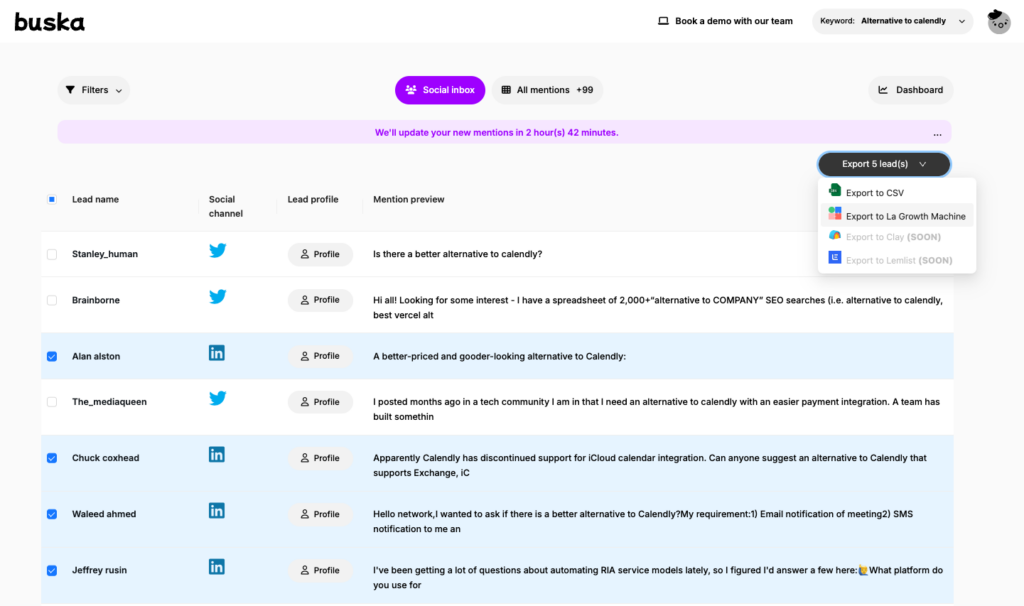“Buyer Intent”: how to use intent data for lead generation

You can impact the way you reach customers by leveraging Buyer Intent, and find people who are already interested in what you offer.
Buyer intent data captures signals from online actions—like mentioning a specific product on social, visiting certain pages or downloading specific content—that show how likely someone is to buy.
By using this information, sales teams can focus on high-intent leads and create strategies to connect with them better.

What Is Buyer Intent?
Buyer intent shows how ready a potential customer is to make a purchase.
It uses data from observed behaviors, such as which websites they visit, the content they read, and how they interact online. You will learn what prospects are interested in through these actions, and identify where they are in their buying journey.
For example, if someone keeps visiting a product comparison page or reads a lot of articles about your solution, they are probably close to making a decision.
Tracking these interactions can help you connect with these high-potential customers at the right time.
Types of Buyer Intent Data
To get the most out of intent data, it’s important to understand where it comes from.
Intent data is usually divided into two types:
- First-Party Intent Data:
This is usually the information collected from your own digital platforms, like Google analytics or CRM tools.
If a prospect keeps visiting specific service pages, downloads case studies or reads related blog posts, these actions show their interest level.
First-party data gives you direct insights into what prospects find important, which you can use to engage with them. - Third-Party Intent Data:
This data is collected from other sites by third-party tools and shows behavior across different platforms.
For example, if a prospect is looking for similar solutions or engaging on related topics on social media sites, it shows growing interest in your field.
Combining these insights with your data helps you understand your prospects better.
Signals monitored can go from website visits to competitor online mentions for example.
How Buyer Intent Data Improves Sales Efficiency
Using buying intent data can make your sales processes more efficient. It lets you focus on high-quality leads instead of wasting time on uninterested prospects.
Here’s how:
Focused Lead Generation
Instead of trying to reach everyone, you will focus on prospects who are already interested in your offerings. By putting effort into these leads, you can increase the chances of conversion and reduce the costs of broad outreach.
Platforms such as buska, a social listening tool for lead generation, can help you find online mentions and track important keywords, so you can focus on leads already showing interest in your industry.
Personalized Content and Messaging
Buyer intent data helps you create content that connects with your audience.
Knowing what topics interest your prospects allows you to make resources—like blogs, guides, or whitepapers—that solve their specific problems.
For instance, buska helps you track mentions of your brand or competitors across social platforms, making it easier to customize outreach and create messages that match customer interests.
Better Ad Campaigns
Ads based on buyer intent data ensure that your content reaches the right people at the right time.
If someone has been researching your product category, you can create ads that meet their needs, moving them along the sales process.
Optimizing Sales with Buyer Intent Insights
For sales teams, intent data is a big advantage because it shows which leads are more likely to convert. Here’s how it can be used:
Prioritizing Leads
Not all leads are equal. By scoring leads based on their engagement with your content, you can focus on prospects who show stronger buying signals.
For example, when you track social intent through mentions with buska, your sales team gets a clearer picture of which prospects are interested and more likely to convert. Because those leads are aware of what you can provide, or the problem you are trying to solve.
Timing Outreach
Timing is key in sales, and intent data helps you know the best time to reach out.
If a prospect starts visiting your site more often or interacts with product pages, it could mean they’re ready to buy. Engaging with them at this stage can improve your chances of closing the deal.
It’s about reaching out to the right person at the right time.
How to Use Buyer Intent Data in Your Strategy
Using buyer intent data in your marketing and sales strategy doesn’t have to be complicated.
Here are some steps you can take:
Collect and Analyze Data
Start by collecting intent data from different sources.
Website analytics tools, CRM software, and third-party data platforms can all give you valuable insights. Use 3rd party tools like buska to track social media mentions of important keywords, helping you understand what potential customers are talking about.
Segment Your Audience
Not all prospects are at the same stage in their journey.
Segment leads based on their behaviors and level of engagement. For example, leads who have downloaded a case study or interacted with your product demo might be closer to buying than those who have only visited your blog.
Personalize Outreach
With segmented data, customize your messaging based on each prospect’s interests and behaviors. For example, email campaigns can target specific segments with content that matches their stage in the buyer journey. Personalizing interactions with buyer intent data helps prospects feel understood and valued, increasing the chance of conversion.
Monitor and Adjust
Buyer intent changes over time. Keep monitoring engagement patterns and adjust your approach as needed. If certain types of content are working well, consider creating more resources like that. Regular analysis keeps your strategy relevant and effective.
The Future of B2B sales with Buyer Intent Data
The importance of buyer intent data in B2B sales is growing. As buyers do more research online before reaching out, understanding and acting on intent data gives you a competitive advantage.
No more spray and pray, sending emails to thousands of leads without a clue of your target audience and their needs.
In the end, buyer intent data helps you make better decisions and connect with leads when they’re most ready to engage.
Target efficiently, and reach the right person at the right time.

